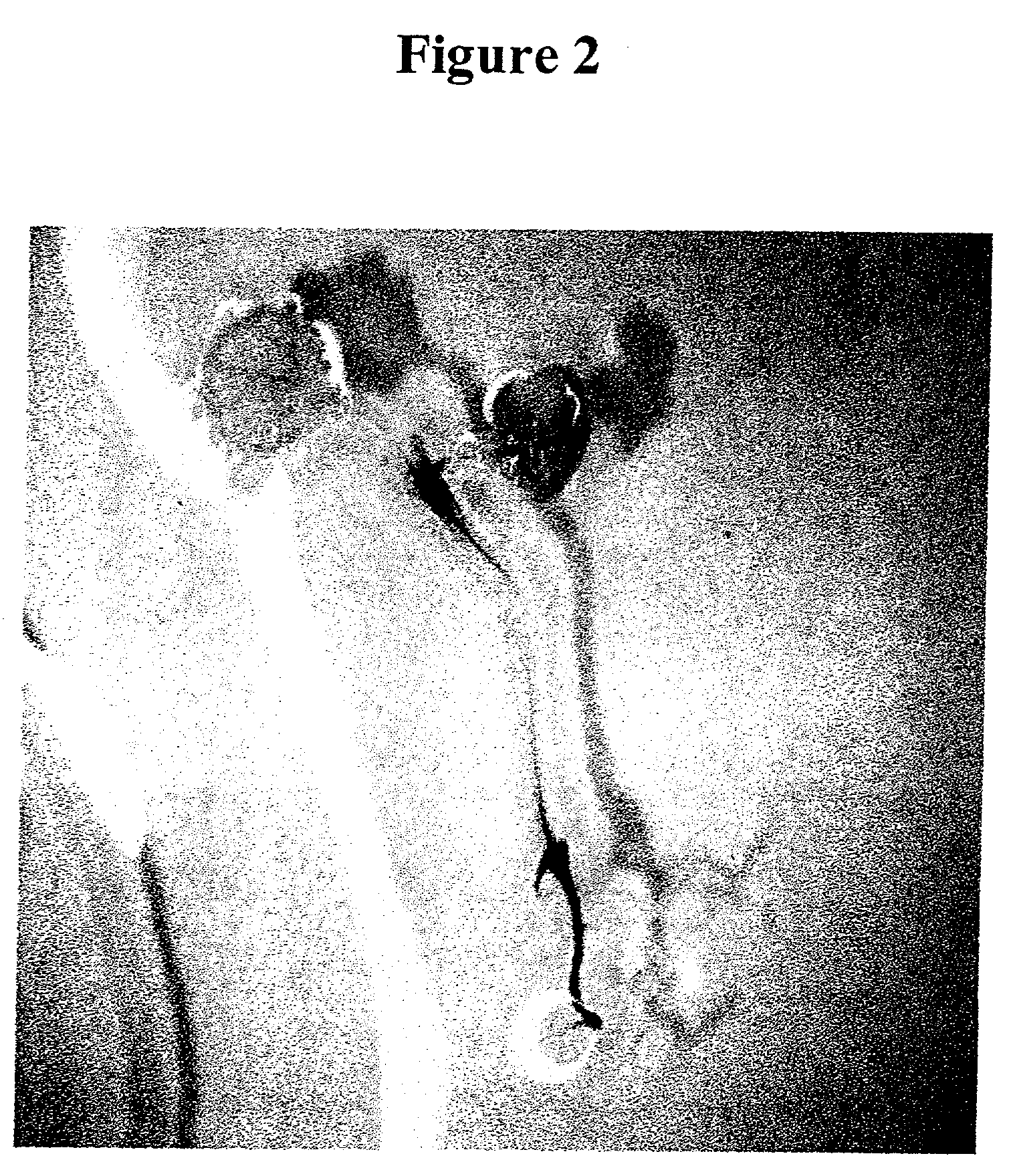Root-specific, stimulant inducible promoter and its use
a plant promoter and stimulant technology, applied in the field of plant molecular biology, can solve the problems of undesirable changes in the oil composition of cells in the plant, and achieve the effect of reducing the risk of toxicity and toxicity
- Summary
- Abstract
- Description
- Claims
- Application Information
AI Technical Summary
Benefits of technology
Problems solved by technology
Method used
Image
Examples
example 1
Cloning and Identification of IFS1 Promoter Sequences
[0064]The IFS promoter was cloned using two rounds of DNA walking following the protocol provided with the Universal GenomeWalker Kit (Clontech Inc., Palo Alto, Calif.) with minor modifications. Two gene-specific primers required by the protocol were designed from the IFS1 gene sequence (Genebank Accession No. AF195798; SEQ ID NO:1) which contains 66 nucleotides 5′ of the initiatior Methionine ATG codon. Primer1 (SEQ ID NO:2) corresponds to the complement of nucleotides 135–169 and Primer2 (SEQ ID NO:3) corresponds to the complement of nucleotides 10 through 45 of the IFS1 gene sequence.
[0065]
(SEQ ID NO:2)Primer1:5′-GGTTTGGGAGGTGGCGAAGTGCTTTTGATTTTG-3′(SEQ ID NO:3)Primer2:5′-CTGTTGTTGGTTTCTGTGATCCCGAGTTTGAGTG-3′
[0066]Genomic DNA from soybean (Glycine max cv. Wye) leaf tissue was extracted using the DNeasy Plant Maxi Kit (Qiagen Inc., Valencia, Calif.) following the manufacturer's protocol. The resulting DNA was digested with the s...
example 2
Transient Expression of GUS Under the Control of the IFS1 Promoter in Soybean Seedlings
[0079]The activity of the IFS1 promoter was tested by its ability to direct the expression of the β-glucuronidase (GUS) reporter gene in transient assays in soybean seedlings. For this purpose, the 35S promoter in plasmid pMH40 was replaced for the newly isolated IFS1 promoter.
[0080]Plasmid pMH40 is derived from plasmid pGEM9z (Promega, Madison, Wis.) and contains a 1.3 Kb 35S promoter fragment from CaMV that extends 8 bp beyond (i.e., 3′ of) the transcription start site coupled to a 60 bp untranslated leader DNA fragment derived from the chlorophyll a / b (cab) binding protein gene 22L. The cab leader is operably linked to the 5′ end of the uidA coding region, which encodes GUS, and to an 800 bp DNA fragment containing the polyadenylation signal sequence region from the nopaline synthase gene. This plasmid is described in PCT publication No. WO 98 / 16650. A “pMH40 minus 35S promoter plasmid” was pre...
example 3
Transient Expression of GUS Under the Control of the IFS1 Promoter in Rice Roots
[0084]The ability of the IFS1 promoter to transiently direct the expression of GUS in the roots of a monocot was tested by bombarding rice seedlings and roots with pOY175 (containing GUS under the control of the IFS1 promoter) followed by histochemical analysis.
[0085]Rice seed of the Nipponbare variety were germinated in the dark on wet filter paper and incubated for 6 days. Whole seedlings and roots detached from the seedlings were bombarded with gold particles coated with 3 μg of DNA from either pOY175 or pML63 following the protocol described in Example 2. Plasmid pML63 is derived from pMH40 (described above) by substitution of the 0.7 Kb fragment containing the Nos3′ end for a 0.3 Kb fragment. Following bombardment the roots were incubated in the dark for 16 hours and then transferred to GUS buffer at 37° C. for 16 hours. No GUS activity was observed in the rice shoot bombarded with pOY175 DNA althou...
PUM
| Property | Measurement | Unit |
|---|---|---|
| length | aaaaa | aaaaa |
| pH | aaaaa | aaaaa |
| diameter | aaaaa | aaaaa |
Abstract
Description
Claims
Application Information
 Login to View More
Login to View More - R&D
- Intellectual Property
- Life Sciences
- Materials
- Tech Scout
- Unparalleled Data Quality
- Higher Quality Content
- 60% Fewer Hallucinations
Browse by: Latest US Patents, China's latest patents, Technical Efficacy Thesaurus, Application Domain, Technology Topic, Popular Technical Reports.
© 2025 PatSnap. All rights reserved.Legal|Privacy policy|Modern Slavery Act Transparency Statement|Sitemap|About US| Contact US: help@patsnap.com


